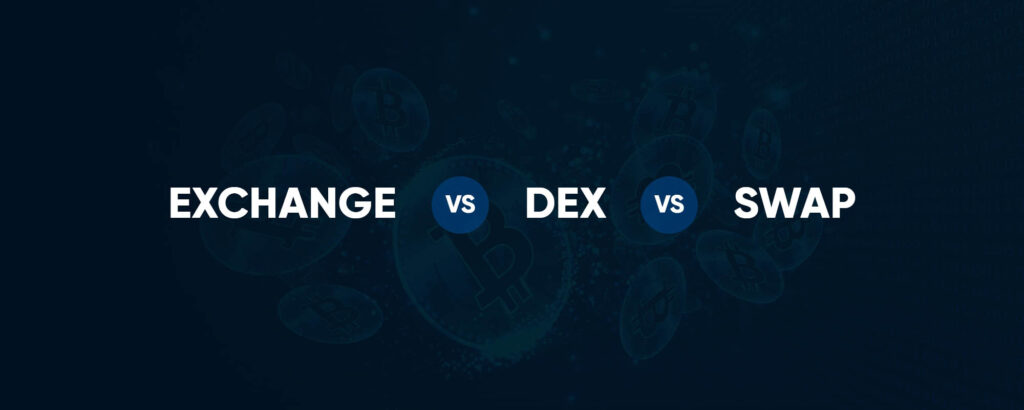Centralized Exchange, Decentralized Exchange, and Crypto Swap are the three essential terms associated with cryptocurrency exchanges. These are innovations that have changed the traditional cryptocurrency trading structure. This article briefly explains each type of exchange with its pros and cons.
To understand that, let’s look at some of the basics.
- What is a Centralized Exchange?
- How does a Centralized Exchange work?
- What is a Decentralized Exchange (DEX)?
- How does a Decentralized Exchange work?
- What is a Crypto Swap?
- How does Crypto Swap work?
- Difference between CEX, DEX, and Crypto Swap
- Takeaway
What is a Centralized Exchange?
A centralized exchange (CEX) is an online exchange platform where digital assets like Bitcoin, Litecoin, Ether, etc., are traded. CEXs are similar to traditional stock exchanges, the only difference being that a user can convert fiat money to a cryptocurrency.
A central authority governs all CEX transactions. Centralized exchange authorities have an order book that stores users’ data and regulates the demand and supply of cryptocurrencies against fiat currencies. CEXs fix the fees that are incurred at the time of trading.
Popular centralized exchanges are Binance, CEX.io, OKEx, FTX, KuCoin, and Kraken.
How does a Centralized Exchange work?
Centralized exchanges work like stock exchanges because they facilitate buying, selling, and exchanging digital assets instead of shares. As a rule, CEXs work under regulatory supervision with specific built-in KYC policies. Traders need to trust this centralized authority to perform trades on the exchange.

Users on CEXs cannot exchange assets directly. The exchange takes over the custody of funds that users deposit. It then issues an equivalent amount of I Owe You’s (IOUs) to the traders. Traders can exchange these IOUs only at the time of withdrawal.
IOUs can, therefore, be said to play the role of smart contracts in CEXs since they are an informal document acknowledgment that represents the debt one party owes to another.
Centralized exchanges adopt the Order Book Method to execute trades. An order book records and validates every open order, thus enabling the buying and selling of assets to traders. If a user wants to buy a particular asset, he must disclose the asset’s estimated price to the middle man involved in that exchange.
Once the middleman finds a seller whose request matches that of the buyer, it swaps the assets and completes the exchange between them.
Related article on How to launch a cryptocurrency exchange?
What is a Decentralised Exchange (DEX)?
Decentralized exchanges (DEXs) offer a centralized exchange core function, the only difference being that it is not based on internal services. DEXs are built on blockchain and allow users to trade their digital assets on a secure and transparent platform.
DEXs eliminate the need for intermediaries by substituting their role with self-executing smart contracts that help simplify the exchange process. In a decentralized exchange, buyers and sellers can trade directly without an intermediary.
Curve (CRV), Uniswap (UNI), Balancer (BAL), GDEX, Nash Exchange, Tomo DEX, ViteX, and Loopring Exchange are some popular decentralized exchanges used worldwide.
Related article on What is Initial Dex Offering or IDO? The benefits of IDO fundraising
How does a Decentralised Exchange work?

Decentralized exchange implements either of the following two mechanisms to complete a trade.
The first is the order book method which works similar to a centralized exchange, except it uses smart contracts instead of an intermediary. An order book records and validates all open orders. The buyer sends an asset’s estimated price to the smart contract. Once the smart contract finds someone whose request matches the buyer, it swaps the help and gives the buyer the asset he was willing to buy.
To sell an asset on a Decentralised exchange, a user needs to submit the asset to the smart contract and wait until the contract finds suitable buyers. The seller has the liberty to check out the order book, find a buyer, agree to his terms, and complete the exchange.
Related article on Decentralized lending and borrowing with DeFi
The second mechanism employed by Decentralised Exchanges is the automated market marker method (AMM). Uniswap and Sushiswap are two popular platforms that use this mechanism.
On AMM-based DEXs, the traditional market of buyers and sellers is replaced by a liquidity pool.
An AMM, similar to order books, works with trading pairs. However, a trader does not need a counterparty on the other side to make a trade. In AMMs, traders trade against a liquidity pool, which follows the principle of demand and supply. Users on the exchange supply tokens to liquidity pools and the price of the tokens in the collection is determined by a mathematical formula.
Instead of providing tokens to liquidity pools, liquidity providers earn fees from the trades in their collection.
What is a Crypto Swap?
In cryptocurrency, swapping refers to exchanging one coin or token for another. Crypto swap allows the instant exchange of two non-native tokens between two different blockchain protocols without traditional token migration.
Crypto swapping is a seamless process that allows traders to acquire the coin they want instantly. Users can exchange tokens directly from the official trading account or the private key wallet.
Some popular swap-enabled exchanges are Changelly, ChangeNow, Shapeshift, Swap Space, and Simple Swap.
Related article on Getting started with crypto token swaps
How does Crypto Swap work?

A swap-enabled exchange platform allows users to trade native tokens for a non-native tokens directly from the official crypto wallet. The user must add the total amount for which exchange is to be done and the desired trading pair. The token swap service will instantly process and convert your coin based on this information.
Difference between CEX, DEX, and Crypto Swap
| CEX | DEX | Crypto Swap | |
| Regulation | By a centralized entity | Used smart contracts with no centralized entity | Used smart contracts to regulate crypto swaps |
| Verification | Required; done with KYC | Not needed; anonymous trading | Not required |
| Security | Under the control of third parties. Exchanges are prone to security breaches, hacks, and data manipulation. | Robust; expert validators validate each transaction | Equally secure are DEX |
| Risk Factors | Exchange is responsible for the security | Users are responsible for the security | Users are responsible for the security |
| Fees | Costly because of the involvement of the third party | It’s affordable with zero commission and transaction fees. | No network fees on trading account to trading account swap. Charges involved in a private key wallet to the trading account and personal key wallet to private key wallet swap |
| Customer Support | Available | Not available except for the community forum | Not available |
If you plan to launch a cryptocurrency exchange, consult with a reliable blockchain development company to do a feasibility analysis to choose the right blockchain platform for your project.
Read more: How to choose the right Blockchain as a Service provider?
Takeaway
CEXs, DEXs, and Crypto Swaps co-exist with their respective pros and cons. They may be governed by different mechanisms but have a common goal of promoting virtual trading. Crypto experts expect DEXs to witness an exponentially rising market share in the future. CEXs continue to hook virtual traders with user-friendly interfaces and robust regulatory features. Irrespective, they continue to popularise cryptocurrency trading among the masses worldwide.


